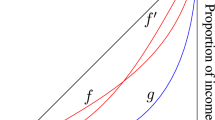Abstract
In a previous paper Gastwirth shows that a broad family of measures of inequality can be accurately estimated when the tax data are known in groups (more precisely, when we know the number of returns in each of several class intervals and their corresponding average income). In the present paper we show that some measures of the preceding family can be unbiasedly estimated when the tax data are individually known for a sample from the population. Specifically, we construct unbiased estimators of a particular measure of inequality in the samplings with and without replacement, and in the stratified samplings with and without replacement.
Similar content being viewed by others
References
Aigner, D. J. and A. J. Hein (1967), A social welfare view of the measure ment of income equality, Review of Income and Wealth 73, 12–25.
Atkinson, A. B. (1970), On the measurement of inequality, Journal of Economic Theory, 2, 244–263.
Bentzel, R. (1970), Measures of income inequality, Review of Income and Wealth.
Bourguignon, F. (1979), Decomposable income inequality measures, Econometrica, 47, 901–920.
Cowell, F. A. (1980), On the structure of additive inequality measures, Review of Economic Studies, 47, 521–531.
Eichhorn, W. and W. Gehrig (1982), Measurement of Inequality in Economics, in: B. Korte ed.: Modern applied Mathematics-Optimization and Operations Research (North-Holland, Amsterdam).
Gastwirth, J. L. (1972), The estimation of the Lorenz curve and Gini index, The Review of Economics and Statistics, 63, no. 3, 306–316.
Gastwirth, J. L. (1975), The estimation of a family of measures of economic inequality, Journal of Econometrics, 3, 61–70.
Gil, M. A., Pérez, R. and I. Martínez (1986), The Mutual Information. Estimation in the sampling with replacement, R. A. I. R. O.—Rech. Opér., Vol. 20, no 3.
Herfindahl, O. C. (1950), Concentration in the steel industry, Ph. D. dissertation (Columbia University, New York).
Pérez, R., Gil, M. A. and P. Gil (1986), Estimating the uncertainty associated with a variable in a finite population, Kybernetes (in press).
Shorrocks, A. F. (1980), The class of additively decomposable inequality measures, Econometrica, 48, 613–625.
Theil, H. (1967), Economics and Information Theory (North-Holland, Amsterdam).
Zagier, D. (1983), On the decomposability of the Gini coefficient and other indices of inequality, Discussion paper No. 108, Projektgruppe Theoretische Modelle (Universität Bonn).
Author information
Authors and Affiliations
Rights and permissions
About this article
Cite this article
Pérez, R., Caso, C. & Gil, M.A. Unbiased estimation of income inequality. Statistische Hefte 27, 227–237 (1986). https://doi.org/10.1007/BF02932569
Received:
Issue Date:
DOI: https://doi.org/10.1007/BF02932569



